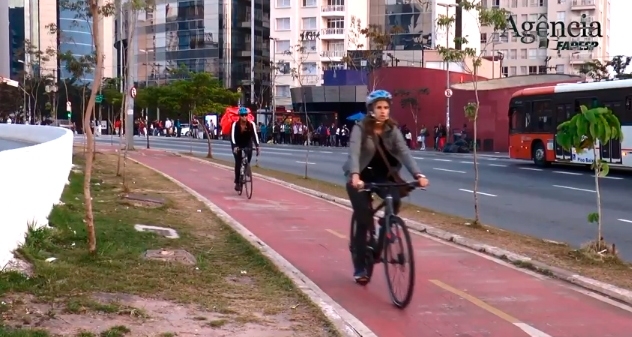

Survey by Brazilian researchers shows that people who live in the vicinity of cycling lanes and bike paths are 154% more likely to use a bicycle for transportation (photo: Daniel Antônio / Agência FAPESP)
Survey by Brazilian researchers shows that people who live in the vicinity of cycling lanes and bike paths are 154% more likely to use a bicycle for transportation.
Survey by Brazilian researchers shows that people who live in the vicinity of cycling lanes and bike paths are 154% more likely to use a bicycle for transportation.

Survey by Brazilian researchers shows that people who live in the vicinity of cycling lanes and bike paths are 154% more likely to use a bicycle for transportation (photo: Daniel Antônio / Agência FAPESP)
By Maria Fernanda Ziegler | Agência FAPESP – Research conducted in various parts of the world evidences a direct correlation between the implementation of cycling lanes or bike paths and growing numbers of cyclists in a city. São Paulo, the largest city in Brazil and the southern hemisphere, is a case in point.
One study shows that having a bikeway within 500 meters of one’s home and a train or subway station within 1,500 m is a major incentive to use a bicycle for commuting or other kinds of urban travel.
The study was supported by FAPESP and conducted by researchers at the University of São Paulo’s School of Arts, Sciences & Humanities (EACH-USP) and its School of Public Health (FSP-USP), in collaboration with colleagues at the University of Melbourne in Australia.
According to results published in the International Journal of Environment Research and Public Health, people who live in the vicinity of bikeways are 154% more likely to use a bicycle for transportation. The likelihood increases 107% for those who live near a train or subway station, regardless of gender, age, education, or location of their home, among other variables.
“The key question is whether bikeways can help increase the use of bicycles. Since it became official policy to build bikeways in São Paulo three years ago, many vocal critics have complained that no one was using them. This is short-termism. Our study highlights the need to start by guaranteeing the space, especially in a city like São Paulo with such violent traffic that deters cyclists,” said Alex Florindo, a professor at EACH-USP and first author of the study.
According to the article, the tendency for bikeways to drive bicycle use is also true of high-income countries. “Countries seen as a benchmark for bicycle use, such as Denmark and the Netherlands, where more than 25% of commutes, school runs and so on are made by bicycle, first underwent a process of guaranteeing space for cyclists, and only later experienced a significant rise in bicycle use,” Florindo told Agência FAPESP.
Despite the boost from bikeways, the prevalence of cycling for transportation in São Paulo remains low, at only 5.1% of the adult population. According to the study, this contingent consists mainly of single men who have their own bicycles.
“A prevalence of 5.1% is very low,” Florindo said. “Bicycle use is associated with various benefits both for individuals and the city as a whole. Cycling is healthy exercise and combats obesity, cardiovascular problems and other diseases relating to sedentarism. It contributes to traffic improvements by reducing the number of cars. And it reduces pollution,” Florindo said.
Incentive programs
The study was based on data from the São Paulo Health Survey (ISA), a cross-sectional study conducted in collaboration with the city’s Health Department in 2015, when a policy of building cycling paths and implementing cycling lanes was in effect.
For the researchers, the low prevalence of bicycle use for commuting and similar urban travel in São Paulo points to the need for incentive programs, education campaigns and bicycle-sharing schemes.
“People and especially families should be encouraged to use bicycles,” Florindo said. “Bicycles are still considered a huge risk in a city with violent traffic that’s often hostile to cyclists. Hence, the importance of weekend bikeways for people to start using a bicycle. We also need improved bike-sharing schemes and bike parks at train and subway stations.”
The article also compares the situation in São Paulo with those of other Brazilian cities. It says the prevalence of bicycle use for urban transit by adults averages 13.3% nationwide, ranging from 8.8% in Vitória to 16.6% in Recife. In cycling-friendly European countries, the average is far higher. In the Netherlands, for example, more than 27% of trips are made by bicycle.
The researchers will now conduct a longitudinal study of the activity. “We’ll interview the same people as for the 2015 survey to find out what’s changed with regard to the built environment and this increase in bikeways,” Florindo said. “We know the policy of incentivizing bikeways in the city has been discontinued. We want to see to what extent this has impacted bicycle use.”
In the new study, the researchers will also measure other variables of the built environment, such as parks and squares, as well as health-related factors, including physical exercise, diet and body weight. “This should give us answers on the possible impact of the environment on health outcomes,” Florindo said.
The article “Cycling for transportation in Sao Paulo City: associations with bike paths, train and subway stations” (doi:10.3390/ijerph15040562) by Alex Antonio Florindo, Ligia Vizeu Barrozo, Gavin Turrell, João Paulo dos Anjos Souza Barbosa, William Cabral-Miranda, Chester Luiz Galvão Cesar and Moisés Goldbaum is published in Int. J. Environ. Res. Public Health and can be read at www.mdpi.com/1660-4601/15/4/562.
Republish
The Agency FAPESP licenses news via Creative Commons (CC-BY-NC-ND) so that they can be republished free of charge and in a simple way by other digital or printed vehicles. Agência FAPESP must be credited as the source of the content being republished and the name of the reporter (if any) must be attributed. Using the HMTL button below allows compliance with these rules, detailed in Digital Republishing Policy FAPESP.




